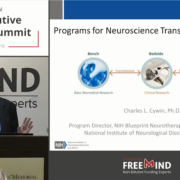SBIR Show Stoppers
After months of hard work developing your SBIR proposal, there’s nothing quite as disappointing as having a few preventable errors keep your application from getting reviewed.
Recently, the NIH’s Center for Scientific Review (CSR) published their “Top 10 Submission Show Stoppers for NIH Small Business Applicants – SBIRs.” At FreeMind, we took a look at the top CSR preventable errors and suggested how to best tackle these ahead of time.
- Not Having Multiple Registrations in Place: The SBIR/STTR application process requires five. Your application needs to pass through the government-wide portal (Grants.gov). To do this, your company needs an active System for Award Management (SAM) account, which expires after 12 months. To get this account, your company needs a DUNS number, a Taxpayer Identification Number (TIN), and a CAGE code. Getting these numbers and having an active account can take up to 8 weeks. Complete these registrations early so you and your collaborators can be ready on submission day. You and your institution also need separate NIH eRA Commons registrations.
FreeMind: The CSR is entirely correct that proper registration is vital to submission, you can’t technically submit without this. However, they have overlooked another required registration to the SBA. A downloadable PDF is actually required from that site in your application package.
- Failing to Appreciate the Fact that Submission Is a Multi-Step Process: Your application must pass through Grants.gov and then through the NIH eRA system. These systems have separate checks/validations. If your application is stopped at Grants.gov, be sure to alert both help desks immediately. After eRA acceptance, NIH staff performs additional, manual compliance checks.
FreeMind: This is correct, and exactly why you should aim at submitting ahead of time. The helpdesks can indeed be very helpful, and make sure to keep your ticket number for later reference. One item of note here is that the new submission system for the NIH “ASSIST” does the compliance error checks before submission, which does save a little time. *This isn’t relevant if submitting via PDF package.
- Submitting Your Application at the Last Minute: Electronic submission errors can take hours to fix. Give yourself peace of mind and submit early—days, not hours or minutes! Only error-free applications submitted on time can be sent forward to reviewers.
FreeMind: Not much to say here except to enthusiastically agree. You’ll be doing yourself a favor by planning and managing your time correctly, targeting a 24-48 hour pre-deadline submission.
- Attempting to Fix a Warning after the Deadline: Warnings are not show stoppers. Your application will be accepted with a warning. But if you seek to fix a warning after the submission deadline by rejecting your application and submitting a corrected one, your application will be late and will not go forward.
FreeMind: This is a technical point, and a fine one to be made. There are very few [acceptable] reasons to submit after the deadline. And, if you already had your application in the system, there’s no acceptable reason to submit a correction after the deadline. Errors must be fixed (if not using ASSIST), but warnings will not stop the submission.
- Not Using the Right Application Form: Different types of grants (with different activity codes) have different forms, and the forms can change. Make sure you are using the right one. Go to the NIH Guide to Grants and Contracts and pull up the Funding Opportunity Announcement (FOA) associated with the specific grant you want. You will be directed to the right form. Our forms are regularly updated, so don’t assume last year’s form will work!
FreeMind: The recent move to Forms-D exemplifies this point exactly. Always keep your eye open and finger on the pulse in regards to what are the correct forms.
- Not Giving the SBIR/STTR Instructions Enough Attention: They hold the keys to a successful submission and contain step-by-step guidance and specific submission and review considerations for your proposal.
FreeMind: The devil is in the details. Beyond just getting your grant in there for review technically, there’s a lot that you need to consider, plan and fret on in order to out that excellent proposal that has a chance of winning. Review considerations are a good place to start, but there are lot of informal improvement items not mentioned there.
- Producing an Incomplete Application: Including appropriate details in your research proposal is important, so make sure your final grant package has everything you need. Be sure to provide enough information in the Research Strategy section for reviewers to understand what problem you aim to solve, what experimental methods you will employ, how you plan to analyze the results, and what your milestones for success are. Also, make sure to include your budget! Applications lacking sufficient detail cannot be sent to reviewers.
FreeMind: In brief, you MUST get the reviewers enthusiastic about your work. They can’t do that if they don’t know what you’re doing, why, and how.
- Overstuffing Your Application: NIH will not let you exceed the page limit by putting important research strategy information in sections of the application that are not page-limited, such as the Vertebrate Animals or Human Subjects sections.
FreeMind: You might be tempted to put in that missing explanation on using a certain animal model tacked on with a little preliminary results you have on the model in the vertebrate Animals section. After all, 12 pages for Research Strategy is indeed very limited. Don’t do it. It’s quite possible that the reviewers will disqualify you for this.
- Submitting a New Application but Referring to Previous Review Outcomes or Criticism: Since NIH now accepts previously reviewed applications as “new,” be careful not to refer to the score of the earlier application or discuss how reviewer comments were addressed.
FreeMind: Indeed a “new” proposal is exactly that – new. It’s definitely tempting to address critiques, but leave that for resubmissions.
- Using a Small Font: NIH can withdraw your application before review if you ignore standards for font and text size. Even if we don’t withdraw such an application, reviewers will likely struggle to read your application and see its merits.
FreeMind: Always stick with the guidelines for font, margins, page limits, etc. No fooling around here. We’ve seen applications dismissed for using the wrong font type.
To summarize and conclude, there are many pitfalls and challenges in submitting a successful SBIR or STTR grant to the NIH. Some of these are indeed technical – and the CSR has mentioned some of these above. It should be noted however, that a technically fit SBIR proposal is a far cry from a winning proposal. It is defining your aims correctly, planning your endpoint milestones prudently, and many additional, non-technical but highly relevant attributes that make up a winning proposal. We will be discussing some of these in later blog entries.
Joel Knopf
Manager of Consulting Services












Leave a Reply
Want to join the discussion?Feel free to contribute!